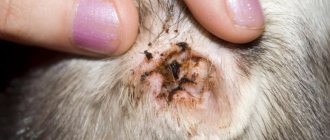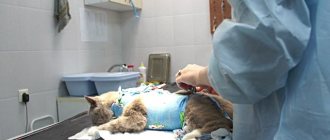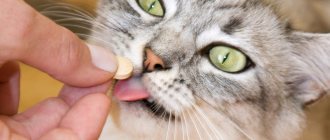The cat is a very active pet. He loves to climb trees, jump, get into hard-to-reach places, and even sometimes fight. But such pranks do not always end well; the cat quite often inflicts various injuries on itself.
One of the most common problems affecting our furry friends is ear disease. How to determine the location of an injury or understand the cause of your cat's anxiety? First you need to observe the symptoms.
Symptoms
If your cat has swollen ears, the following symptoms may appear:
- elevated temperature;
- odor from the ear;
- redness or swelling of the skin;
- the cat walks with its head tilted, shakes or twitches it, scratches its ears with its paws.
There may be several reasons why a cat's ear is swollen. Let's look at the main ones.
Ticks (otodectosis)
This is one of the common cat diseases. In 80% of cases this is what is diagnosed. The disease is caused by a mite called Otodectes cynotis, which parasitizes your pet's skin in the upper layers of the epidermis.
Ticks can appear when a healthy animal comes into contact with a sick animal, and can also enter the body through fleas or flies. Many may ask: “Why does my furry dog have mites, since we always stay at home?” The answer is simple: the person himself could carry the infection, for example, on shoes or clothes, although this parasite is not dangerous for us!
Mostly kittens up to one year old or adults with weakened immune systems get sick. Moreover, the disease mainly begins in the summer, because ticks love warmth.
Treatment
If a cat's ear is swollen due to ticks, what should I do?
To defeat the disease, you must follow the following stages of treatment:
- Treat the ear canal with an antiseptic. Remove all crusts and scabs from the damaged area and treat for pus. Hydrogen peroxide can be used as an antiseptic. Use cotton swabs when cleaning the ear canal.
- Use of anti-tick drugs. After treating the animal's ears, you need to massage them thoroughly.
- If the disease is advanced, you may need acaricidal injections.
- If your pet is very concerned about itching and irritation, then you can use the antibacterial agent Otonazole.
- To effectively treat ear mites, you need to take care of strengthening your pet’s immunity. This can be done by adding beneficial minerals and vitamins to your diet.
Fungal infection of the ear
Otitis of fungal etiology, or otomycosis, is an inflammation of the hearing organ, provoked by pathogenic or conditionally pathogenic fungi. Often this disease develops against the background of bacterial infections or ticks. The disease can be identified by unbearable itching, pain and redness. The inside of the diseased ear is almost completely covered with waste products of fungi. They look like greenish-gray cotton wool. The blockage often leads to hearing loss. Pus is released extremely rarely.
What should I do to alleviate my pet’s condition? It is necessary to clean the ear canal daily. Douching it is strictly prohibited. After cleaning, the ears should be wiped with an antiseptic alcohol solution. In the treatment of otomycosis, 1% Econazole has proven itself well. If there is a suspicion of a violation of the integrity of the eardrum, it is better to use 1 percent Tolnaftate.
Otitis (middle ear disease)
If your cat's ear is swollen, otitis may be the cause. It is most often caused by parasitic diseases, allergic manifestations (pollen, dry food, dust), bacterial, viral, fungal infections, and injuries. In addition, it may be poor hygiene of the ear canal.
Factors that provoke otitis media are hypothermia, reduced immunity, moisture getting into the ears, genetics (predisposition in the British and Scottish fold breeds).
What is otitis media, what can it be like?
1. Your pillow should be firm enough to keep your spine straight.
2. You should fill the space between your neck and mattress to keep your head and neck in a neutral position.
3. If you have shoulder pain, try placing a pillow in front of your body and resting your arm on it. This will help relieve the pain.
4. To avoid or get rid of hip pain, try placing a pillow between your knees to keep your hips level.
5. To avoid sagging breasts, try placing a small pillow under them to prevent the ligaments from being stretched. Or just sleep on your back.
6. If you wake up in the morning with a puffy face, puffy eyes and deeper wrinkles than last night, you should change your sleeping position. Sleeping on your back can prevent unwanted contact between your face and your pillow.
7. A good mattress is the most important thing when it comes to healthy and restful sleep. If you're a side sleeper, you'll want to choose a mattress with good shoulder and hip support and a medium to firm firmness. Foam mattresses and mattresses that can “remember” your body position (viscoelastic) are the best options as they are very effective at relieving pressure points.
Of course, other reasons can cause pain and swelling. Therefore, do not immediately think about your sleeping position; maybe the problem is completely different, and the wrong position simply aggravates the situation.
Swelling, for example, can be caused by drinking large amounts of water before bed and/or consuming salty and spicy foods.
In any case, sleep in a way that suits your body to avoid any consequences.
This term refers to the inflammatory process in various structures of the ear. There are many varieties of this disease. It is classified according to the factor that provoked its appearance, the speed of development and duration of the course, and the localization of the pathological process. Treatment and symptoms depend on the type of pathology.
Depending on what caused the development of otitis, it is divided into the following types:
- allergic – occurs due to severe damage to the inner surface of the ear due to the reaction of the cat’s body to any allergen (pollen, food, dust, medications, etc.);
- bacterial and fungal - appears as a result of infection by bacteria and fungi, respectively;
- parasitic – caused by parasites.
According to the speed of development and duration of the course, otitis media is divided into:
- acute – the disease develops quickly and lasts from 5 to 14 days;
- chronic - arises from an acute form with improper treatment or its absence and is characterized by a long course with periodic exacerbations.
The last form of the disease is extremely dangerous. It can lead to many serious complications: hearing loss, paralysis of the facial nerves, development of ulcers, inflammation of the brain. The most dangerous consequence of the disease is the death of the animal.
Depending on which area of the hearing organ is affected by the inflammatory process, otitis media is classified into:
- Outer. This is the mildest form of the disease, which affects the external auditory canal and the auricle.
- Average. Inflammation of the middle ear, when the eardrum is involved in the pathological process. This form of pathology often becomes chronic.
- Labyrinthitis. Inflammation of the inner ear. This is the most severe and dangerous form of the disease. In addition to the eardrum, the vestibular apparatus is involved in the inflammatory process. Labyrinthitis is difficult to treat and more often than other types of otitis causes complications. Inflammation of the inner ear is fraught with damage to the membranes of the brain and the development of sepsis.
Main symptoms
If a cat's ear is swollen inside or outside, symptoms include:
- animal anxiety;
- redness and irritation of the skin of the ear;
- pain effect;
- purulent discharge;
- decrease in animal activity;
- lack of appetite.
Experts classify inflammation into three types: external, internal and middle ear. If a cat's ear is swollen from the outside (with otitis externa), the affected tissue is on the surface and does not affect the eardrum. Such otitis media can be easily dealt with.
Otitis media is the most common and most often becomes chronic. With this type of disease, inflammation spreads to the eardrum. The most dangerous is inflammation of the inner ear. Not only the eardrum is affected, but also the vestibular apparatus. Inflammation is accompanied by purulent discharge, which can spread to the brain; in addition, this type of disease can lead to deafness of the animal.
Symptoms of otitis media include:
- the animal tilts its head;
- lopsided muzzle;
- problem with swallowing (due to disruption of the facial nerve);
- trembling of the eyeball (the disease has spread to the brain).
What symptoms of ear pathology require you to contact a veterinarian?
As can be seen from the above, any disease of the hearing organs can result in serious complications for a cat. Most of these pathologies are difficult to diagnose and cannot be treated at home, so you should take the animal to the veterinarian as soon as the first symptoms of the problem are discovered:
- strange behavior;
- increased body temperature;
- swelling or deformation of the ear;
- the appearance of fluid, pus or an unpleasant odor from the ear canal.
Treatment of the disease
If a cat's ears are swollen, what should I do? If your pet exhibits the symptoms listed above, you must immediately contact a veterinary service, where you will be prescribed qualified treatment.
Treatment begins with cleaning the ear canal from scabs, dirt, and pus using antiseptic drugs. If the inflammation is purulent, deep surgical cleaning is an option. After cleaning, the ear is treated with special medications. But remember: you cannot choose the drug yourself! You may harm the animal. Your task as the owner throughout the treatment is to provide your pet with a warm room, free from drafts and dampness.
To prevent otitis media, it is recommended not to allow the animal to become hypothermic, not to wet the ears when bathing, and to maintain hygiene of the ear canals.
Allergic otitis: signs and therapy
Allergic otitis media
Ear inflammation in a cat can be caused by an allergic reaction. It is wrong to think that with allergies, a pet only sniffles, tears flow profusely and sneezes often. The ears are often involved in this process. When mast cells release histamine into the blood, vascular permeability increases, which can lead to changes in the natural microflora of the ear canal.
A sick pet constantly scratches its ears, which causes scratches and sores to appear on them, and hair falls out. Ignoring these symptoms can lead to the development of a secondary infection, in which the cat begins to secrete exudate from the ear canals. At first it may be serous fluid, but over time pus or dead tissue will appear. At the same time, the animal’s muzzle will swell.
If a four-legged patient is diagnosed with otitis media of allergic etiology, he will be prescribed glucocorticoids (Prednisolone), antifungal and (or) antimicrobial drugs. Antibiotics are used because non-steroidal anti-inflammatory drugs, while stopping allergic reactions, greatly reduce immunity, which is fraught with secondary bacterial or fungal infection.
It is also necessary to regularly clean your pet’s ear canals, freeing them from secretions. For cleaning, special pharmaceutical preparations, warm vegetable oil or Vaseline oil are used. Treatment usually takes 1–1.5 months.
Hematomas
There may be another reason why a cat's ear is swollen - hematoma. It resembles a swelling, which is provoked by hemorrhage in the area between the cartilage and the skin of the ear.
The formation of a hematoma can be caused by mechanical damage, since the ear skin has a very thin structure, which is equipped with many capillaries. When a vessel is damaged, blood accumulates between the tissues, after which it acquires a bluish tint. Such injuries are most often sustained by cats that have free access to the outdoors. Your active pet can get injured anywhere from a fall from a tree to a fight with a yard dog. Sometimes the cat itself causes damage to blood vessels when scratching its ear.
Causes of the problem and accompanying symptoms
Otitis in cats
Swelling behind the ear or inside the hearing organ is often caused by this pathology, which can be caused by allergic reactions, fungal, viral or bacterial infections, or traumatic injuries. The inflammatory process is usually divided into three types:
When swelling is observed externally, the superficial tissues are affected, the eardrum is not affected. Middle ear disease is characterized by damage to the membrane. The most dangerous is the inflammatory process in the inner ear. In the process of its development, damage is observed not only to the eardrum, but also to the vestibular apparatus. In addition to the fact that the cat's ear swells, it fills with fluid and there is a discharge of pus. Brain damage is possible. Internal otitis media can cause deafness in your pet.
The following symptoms of the disease are distinguished:
- redness of the skin near the hearing organs;
- pain syndrome due to which the cat constantly scratches its ear;
- decreased activity;
- loss of appetite.
Ear mite
If your cat has a swollen ear, in most situations the problem is caused by a parasite called Otodectes cynotis. A cat can catch it through contact with a sick pet. There are often cases when the owner brings a tick into the house along with dirty shoes. In addition to the fact that swelling appears on the ear, the owner may notice the following symptoms:
- constant meowing;
- brown discharge with a bad odor;
- redness of the skin inside the ears;
- general increase in body temperature;
- pet concern.
Neoplasms
Sarcoma, fibroma and papilloma are often diagnosed in the ear canal. The main danger of these formations lies in the fact that, mainly at the initial stage of development, they do not provoke any symptoms at all. As it progresses, the pet owner may notice the following symptoms:
Injuries and hematomas
If there is swelling in a cat's ear, it is often caused by traumatic injuries. Hematomas often occur in pets that have free access to the outdoors. Traumatic injuries are characterized by the following signs:
- change in the shape of the auricle;
- increased ear temperature;
- pain syndrome;
- pet aggressiveness.
Abscess in a cat
It often occurs when there is an open wound that has become infected. Often the inflammatory process is accompanied by suppuration, which can have serious consequences for the body. In addition to the fact that the cat’s ear is swollen, the owner may notice the following symptoms:
- loss of appetite;
- weakness;
- thirst;
- redness of the place where the abscess is localized;
- local temperature increase.
Treatment of hematoma
If a cat has a swollen ear, how to treat it? At the initial stage of a hematoma, it is possible to apply cold. Frozen foods from the freezer are perfect for cooling. You can cool the ear for no more than 15 minutes. If the wound is open, do not forget to disinfect it. In case of a bleeding wound, it is necessary to apply a bandage. And a veterinary service specialist will take care of further treatment and diagnostics.
If the cat has a large hematoma and you are afraid of introducing an infection into the wound, then in this case the surgical method is used. The doctor makes an incision in the area of the hematoma, after which the wound is cleaned of darkened blood, and at the end of the operation a suture and bandage are applied. After such an operation, you must ensure that the cat cannot scratch its ear. To do this, you can use a special collar.
To prevent hemorrhage, adhere to the following rules:
- try to stay close to the animal while walking;
- promptly identify and treat ear diseases;
- rid the animal of parasites in a timely manner.
How does a cat's ear work and what does it normally look like?
How, without being a veterinarian, can you notice in time that your pet has ear problems? For preliminary diagnosis at home, it’s good to have an idea of how your pet’s hearing organs generally work. The cat's ear is made up of three structures.
Outer ear. This includes all (visible and not) parts of the organ from its upper tip to the eardrum:
- The auricle is a cartilaginous plate slightly concave inward (unless otherwise determined by the characteristics of the cat breed). Its outer side is covered with short hair, the inner side is covered with thin skin (the presence of hairs along the edges is acceptable).
- The vertical ear canal , which goes deep into the head and is curved by 90°, has a slightly pinkish (almost whitish) color in the visible part. Hair is absent or represented by individual hairs. Small accumulations of dark brown (the shade of dried blood) earwax, which is produced by glands located precisely in this part of the organ, are acceptable.
- The eardrum serves as the boundary between the vertical and horizontal ear canals. Invisible to the naked eye, it is located in such a way that it is almost impossible to damage it from the outside.
Middle ear. This is a cavity located at the base of the skull, consisting of two interconnected chambers. The outer one contains three auditory ossicles - the malleus, the incus and the stapes, designed to transmit sound waves from the eardrum to the inner ear. It is impossible to see them without special tools.
Inner ear. Protected by the temporal bone and also invisible from the outside, it is represented by:
- organ of Corti - a sensitive device that converts sound waves into nerve impulses recognized by the brain;
- the vestibular apparatus, which is responsible for the animal’s sense of balance and its orientation in space.
Abscess
When tissue is damaged, a purulent-inflammatory process called an abscess may begin.
An abscess in an animal can occur as a result of injury, damage to the skin with infection.
One of the factors that provokes a purulent abscess is the animal’s reduced immunity, age and concomitant diseases. The consequences of an abscess can be serious; the purulent mass can penetrate deep-lying tissues and cause serious harm to the body.
Symptoms of an abscess include:
- decreased appetite, lethargy of the animal;
- the cat constantly drinks water;
- the abscess area has swelling, redness, and heat.
Otitis media in cats: symptoms and treatment at home
If the owners notice swelling or blood from the ear of their pet, they need to contact a veterinarian.
A tumor in a cat’s ear can be benign or malignant, and in the latter case, without timely treatment, there is a high probability of death.
With the neoplasm, the kitten and adult also experience small pimples, peeling of the skin is possible and the hairs in the area of the damaged ear become light.
What is it connected with: the main reasons
A tumor behind a cat’s ear does not always indicate a pathological process. Sometimes a purulent lump or hematoma is a consequence of mechanical damage to the auricle. Swelling and hardening can also occur when a cat has a pimple in the ear canal. Other factors can also influence the violation:
- dermatological disease;
- benign neoplasms;
- hormonal imbalance in the cat’s body;
- inflammatory reaction in the ears;
- malignant tumors of the external auditory canal.
Neoplasms: do they pose a threat?
Various tumors can form on a cat’s ears, which differ in malignant or benign nature. This lump is more often formed in older individuals. Ceruminoma, which affects the sulfur glands of the animal, is more common. The cancer grows rapidly and is fatal. Oncology can be recognized by the following symptoms:
A cancerous tumor differs in its growth rate and is accompanied by symptoms such as discharge from the ear canal.
- the formation of multiple small nodules on the ear;
- addition of infection;
- constant scratching of the cat's ear;
- unpleasant discharge from the ear canal.
Among the most common benign tumors, veterinarians highlight ear atheroma, which is a cystic formation in the sebaceous gland. Such a lump can be removed surgically.
Acne associated with dermatitis
The appearance of flaking, multiple pimples and bumps on a cat’s ears are a consequence of a dermatological disease. Such acne appears due to helminth infection and under the influence of other factors. If you don’t notice the problem in your cat’s ears in time, then soon crusts will form near the ear canal and weeping ulcers. The following symptoms are typical for acne:
- severe itching sensations;
- accumulation of secretions in the ear canal that have an unpleasant odor;
- redness of the skin near the sore ear;
- hearing problems.
Parasite activity
Infection with scabies mites is indicated by severe itching and a strong odor from the ear.
If a tumor appears in the cat's ear area, then it is worth examining the pet for the presence of scabies mites. When infected with such a parasite, the pet develops otodectosis. The main food for the parasite is epithelial tissue and blood. If there is a violation, the animal not only develops a tumor, but also other symptoms:
- severe itching;
- copious discharge of brown color and loose consistency;
- pungent odor from the ear.
Other varieties
A tumor can occur in a cat with the following abnormalities:
- Necrotic process. Occurs against the background of infection, mechanical damage or purulent-inflammatory reaction. Pets that live outside for a long time during the cold season are prone to pathology.
- Hematoma. This type of tumor appears after an insect bite, scratching, or injury to the ear. It is also accompanied by pain and redness.
- Inflammatory reaction. In veterinary medicine, this disorder is called otitis media, which is characterized by itching and profuse discharge.
- Lymphoextravasate. Accompanied by impaired accumulation of lymphatic fluid under the skin of the auricle. It is characterized by slow progression, while the affected area turns red and becomes hot.
Veterinarians recommend regularly examining cats' ears for ulcerative formations that occur due to fungal infection. For such tumors, self-medication is prohibited, especially with the use of ointments.
Abscess treatment
In order not to harm your pet, the best help is to go to the doctor, but if you need to do this urgently, and the cat has a normal temperature and the injury is small, then try to help your cat yourself. What do we have to do:
- Shave the area around the abscess.
- Wash and disinfect your hands.
- Squeeze out the pus using sterile wipes.
- Clean the affected area of pus using a sterile cotton swab.
- Treat the wound with hydrogen peroxide.
- Cover the wound with streptocide.











